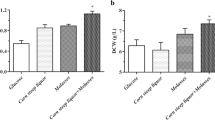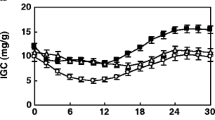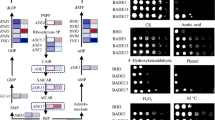Abstract
Batch culture of Candida utilis CCTCC M 209298 for the preparation of selenium (Se)-enriched yeast was carried out under different pH conditions, and maximal intracellular organic Se and glutathione (GSH) contents were obtained in a moderate acid stress environment (pH 3.5). In order to elucidate the physiological mechanism of improved performance of Se-enriched yeast by acid stress, assays of the key enzymes involved in GSH biosynthesis and determinations of energy supply and regeneration were performed. The results indicated that moderate acid stress increased the activity of γ-glutamylcysteine synthetase and the ratios of NADH/NAD+ and ATP/ADP, although no significant changes in intracellular pH were observed. In addition, the molecular mechanism of moderate acid stress favoring the improvement of Se-yeast performance was revealed by comparing whole transcriptomes of yeast cells cultured at pH 3.5 and 5.5. Comparative analysis of RNA-Seq data indicated that 882 genes were significantly up-regulated by moderate acid stress. Functional annotation of the up-regulated genes based on gene ontology and the Kyoto Encyclopedia of Genes and Genome (KEGG) pathway showed that these genes are involved in ATP synthesis and sulfur metabolism, including the biosynthesis of methionine, cysteine, and GSH in yeast cells. Increased intracellular ATP supply and more amounts of sulfur-containing substances in turn contributed to Na2SeO3 assimilation and biotransformation, which ultimately improved the performance of the Se-enriched C. utilis.








Similar content being viewed by others
References
Audic S, Claverie JM (1997) The significance of digital gene expression profiles. Genome Res 7:986–995
Beek AT, Wijman JG, Zakrzewska A, Orij R, Smits GJ, Brul S (2015) Comparative physiological and transcriptional analysis of weak organic acid stress in Bacillus subtilis. Food Microbiol 45:71–82
Brosnan JT, Brosnan ME, Bertolo RFP, Brunton JA (2007) Methionine: a metabolically unique amino acid. Livestock Sci 112:2–7
Casal SG, Far J, Bierla K, Ouerdane L, Szpunar J (2010) Study of the Se-containing metabolomes in Se-rich yeast by size-exclusion–cation–exchange HPLC with the parallel ICP MS and electrospray orbital ion trap detection. Metallomics 2:535–548
Castrillo JI, Kaliterna J, Weusthuis RA, van Dijken JP, Pronk JT (1996) High-cell-density cultivation of yeasts on disaccharides in oxygen limited batch cultures. Biotechnol Bioeng 49:621–628
Dong Y, Wei G, Zhang J, Chen X (2011) Mechanism and effect of acid stress on glutathione biosynthesis by Candida utilis. CIESC J (China) 62:3228–3235
Encinar JR, Ouerdane L, Buchmann W, Tortajada J, Lobinski R, Szpunar J (2003) Identification of water-soluble selenium-containing proteins in selenized yeast by size-exclusion-reversed phase HPLC/ICPMS followed by MALDI-TOF and electrospray Q-TOF mass spectrometry. Anal Chem 75:3765–3774
Fagan S, Owens R, Ward P, Connolly C, Doyle S, Murphy R (2015) Comparison of commercial selenium yeast preparations. Biol Trace Elem Res 166:245–259
Fairweather-Tait SJ, Bao YP, Broadley MR, Collings R, Ford D, Hesketh JE, Hurst R (2011) Selenium in human health and disease. Antioxid Redox Signal 14:1337–1383
Ge X, Wang D, Wei G, Nie M, Shao N (2010) Improvement of physiological characteristic of selenium-enriched Candida utilis with amino acids addition. Biotechnol Res Int 2011:1–7
Haas BJ, Papanicolaou A, Yassour M, Grabherr M, Blood PD, Bowden J, Couger MB, Eccles D, Li B, Lieber M, MacManes MD, Ott M, Orvis J, Pochet N, Strozzi F, Weeks N, Westerman R, William T, Dewey CN, Henschel R, LeDuc RD, Friedman N, Regev A (2013) De novo transcript sequence reconstruction from RNA-Seq: reference generation and analysis with Trinity. Nat Protoc 8(8). doi:10.1038/nprot.2013.084
Iizuka M, Murata K, Kimura A (1988) Induction of glutathione leakage from Saccharomyces cerevisiae cells by selenite. Agric Biol Chem 52:613–614
Kanehisa M, Sato Y, Kawashima M, Furumichi M, Tanabe M (2016) KEGG as a reference resource for gene and protein annotation. Nucleic Acids Res 44:D457–D462
Kieliszek M, Błażejak S (2013) Selenium: significance, and outlook for supplementation. Nutrition 29:713–718
Kieliszek M, Błażejak S, Bzducha-Wróbel A, Kurcz A (2016) Effects of selenium on morphological changes in Candida utilis ATCC 9950 yeast cells. Biol Trace Elem Res 169:387–393
Kieliszek M, Błażejak S, Gientka I, Bzducha-Wróbel A (2015) Accumulation and metabolism of selenium by yeast cells. Appl Microbiol Biotechnol 99:5373–5382
Kim JE, Eom HJ, Kim Y, Ahn JE, Kim JH, Han NS (2012) Enhancing acid tolerance of Leuconostoc mesenteroides with glutathione. Biotechnol Lett 34:683–687
Leng N, Dawson JA, Thomson JA, Ruotti V, Rissman AI, Smits BMG, Haag JD, Gould MN, Stewart RM, Kendziorski C (2013) EBSeq: an empirical Bayes hierarchical model for inference in RNA-seq experiments. Bioinformatics 29:1035–1043
Li R, Yu C, Li Y, Lam TW, Yiu SM, Kristiansen K, Wang J (2009) SOAP2: an improved ultrafast tool for short read alignment. Bioinformatics 25:1966–1967
Li Y, Wei G, Chen J (2004) Glutathione: a review on biotechnological production. Appl Microbiol Biotechnol 66:233–242
Malkowski MG, Quartley E, Friedman AE, Babulski J, Kon Y, Wolfley J, Said M, Luft JR, Phizicky EM, DeTitta GT, Grayhack EJ (2007) Blocking S-adenosylmethionine synthesis in yeast allows selenomethionine incorporation and multiwavelength anomalous dispersion phasing. Proc Natl Acad Sci U S A 104:6678–6683
Mapelli V, Hillestrøm PR, Kápolna E, Larsen EH, Olsson L (2011) Metabolic and bioprocess engineering for production of selenized yeast with increased content of seleno-methylselenocysteine. Metab Eng 13:282–293
Martinez-Munoz GA, Kane P (2008) Vacuolar and plasma membrane proton pumps collaborate to achieve cytosolic pH homeostasis in yeast. J Biol Chem 283:20309–20319
McSheehy S, Kelly J, Tessier L, Mester Z (2005) Identification of selenomethionine in selenized yeast using two-dimensional liquid chromatography-mass spectrometry based proteomic analysis. Analyst 130:35–37
Mortazavi A, Williams BA, McCue K, Schaeffer L, Wold B (2008) Mapping and quantifying mammalian transcriptomes by RNA-Seq. Nat Methods 5:621–628
Nie W, Wei G, Du G, Li Y, Chen J (2005) Enhanced intracellular glutathione synthesis and excretion capability of Candida utilis by using a low pH-stress strategy. Lett Appl Microbiol 40:378–384
Nookaew I, Papini M, Pornputtapong N, Scalcinati G, Fagerberg L, Uhlen M, Nielsen J (2012) A comprehensive comparison of RNA-Seq-based transcriptome analysis from reads to differential gene expression and cross-comparison with microarrays: a case study in Saccharomyces cerevisiae. Nucleic Acids Res 40:10084–10097
Oraby MM, Allababidy T, Ramadan EM (2015) The bioavailability of selenium in Saccharomyces cerevisiae. Ann Agric Sci 60:307–315
Ouerdane L, Mester Z (2008) Production and characterization of fully selenomethionine-labeled Saccharomyces cerevisiae. J Agric Food Chem 56:11792–11799
Pérez-Corona MT, Sánchez-Martínez M, Valderrama MJ, Rodríguez ME, Cámara C, Madrid Y (2011) Selenium biotransformation by Saccharomyces cerevisiae and Saccharomyces bayanus during white wine manufacture: laboratory-scale experiments. Food Chem 124:1050–1055
Schrauzer GN (2006) Selenium yeast: composition, quality, analysis, and safety. Pure Appl Chem 78:105–109
Schrauzer GN (2009) Selenium and selenium-antagonistic elements in nutritional cancer prevention. Crit Rev Biotechnol 29:10–17
Suzuki T, Yokoyama A, Tsuji T, Ikeshima E, Nakashima K, Ikushima S, Kobayashi C, Yoshida S (2011) Identification and characterization of genes involved in glutathione production in yeast. J Biosci Bioeng 112:107–113
Tietze F (1969) Enzymic method for quantitative determination of nanogram amounts of total and oxidized glutathione: applications to mammalian blood and other tissues. Anal Biochem 27:502–522
Tomita Y, Ikeo K, Tamakawa H, Gojobori T, Ikushima S (2012) Genome and transcriptome analysis of the food-yeast Candida utilis. PLoS One 7:e37226
Trapnell C, Roberts A, Goff L, Pertea G, Kim D, Kelley DR, Pimentel H, Salzberg SL, Rinn JL, Pachter L (2012) Differential gene and transcript expression analysis of RNA-seq experiments with TopHat and Cufflinks. Nat Protoc 7:562–578
van Vliet AH (2010) Next generation sequencing of microbial transcriptomes: challenges and opportunities. FEMS Microbiol Lett 302:1–7
Wang D, Yang B, Wei G, Liu Z, Wang C (2012) Efficient preparation of selenium/glutathione-enriched Candida utilis and its biological effects on rats. Biol Trace Elem Res 150:249–257
Wang D, Zhang J, Dong Y, Wei G, Qi B (2015) Glutathione is involved in physiological response of Candida utilis to acid stress. Appl Microbiol Biotechnol 99:10669–10679
Wang Y, Wang D, Wei G, Wang C (2013) Improved co-production of S-adenosylmethionine and glutathione using citrate as an auxiliary energy substrate. Bioresource Technol 131:28–32
Wang Z, Zhang L, Tan T (2010) High cell density fermentation of Saccharomyces cerevisiae GS2 for selenium-enriched yeast production. Korean J Chem Eng 27:1836–1840
Wang ZX, Zhou XZ, Meng HM, Liu YJ, Zhou Q, Huang B (2014) Comparative transcriptomic analysis of the heat stress response in the filamentous fungus Metarhizium anisopliae using RNA-Seq. Appl Microbiol Biotechnol 98:5589–5597
Whanger PD (2004) Selenium and its relationship to cancer: an update. Brit J Nutr 91:11–28
Yang B, Wang D, Wei G, Liu Z, Ge X (2013) Selenium-enriched Candida utilis: efficient preparation with L-methionine and antioxidant capacity in rats. J Trace Element Med Biol 27:7–11
Ye J, Fang L, Zheng H, Zhang Y, Chen J, Zhang Z, Wang J, Li S, Li R, Bolund L, Wang J (2006) WEGO: a web tool for plotting GO annotations. Nucleic Acids Res 34:W293–W297
Yin H, Fan G, Gu Z (2010) Optimization of culture parameters of selenium-enriched yeast (Saccharomyces cerevisiae) by response surface methodology (RSM). LWT–Food Sci Technol 43:666–669
Zhang J, Fu RY, Hugenholtz J, Li Y, Chen J (2007) Glutathione protects Lactococcus lactis against acid stress. Appl Environ Microbiol 73:5268–5275
Author information
Authors and Affiliations
Corresponding author
Ethics declarations
Funding
This work was supported by the National Natural Science Foundation of China (21376155, 21506136), Suzhou Applied Fundamental Research Program (SNG201606), and a Project Funded by the Priority Academic Program Development of Jiangsu Higher Education Institutions. G. Wei was sponsored by Qing Lan Project of Jiangsu Province.
Conflict of interest
The authors declare that they have no conflict of interest.
Ethical approval
This article does not contain any studies with human participants or animals performed by any of the authors.
Additional information
Da-Hui Wang and Gao-Chuan Zhang contributed equally to this work.
Electronic supplementary material
ESM 1
(XLS 3163 kb.)
Rights and permissions
About this article
Cite this article
Zhang, GC., Wang, DH., Wang, DH. et al. The mechanism of improved intracellular organic selenium and glutathione contents in selenium-enriched Candida utilis by acid stress. Appl Microbiol Biotechnol 101, 2131–2141 (2017). https://doi.org/10.1007/s00253-016-8016-4
Received:
Revised:
Accepted:
Published:
Issue Date:
DOI: https://doi.org/10.1007/s00253-016-8016-4




